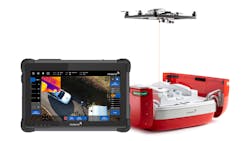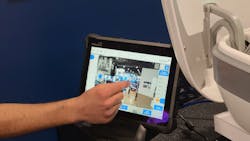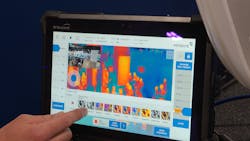Tethered Drone Aids Emergency Response
Check out our AUVSI Xponential 2023 coverage.
Fotokite Sigma incorporates a ground station and a kite. The kit is a tethered hexcopter (Fig. 1). The video (above) provides an overview and demonstration of the system.
Flying the kit is easy since the system handles both launching and landing. It doesn't require a license like a non-tethered drone, making it ideal for emergency and police applications by those who don't have drone expertise. The self-contained system can keep the drone in the air indefinitely since the cable provides power as well as communication with the kite.
The drone is equipped with thermal and visual cameras that can be aimed via the gimbal-stabilized, 3-axis mount. The tablet-based user interface is designed for ease of use and uses a point and tap interface for aiming and zooming. Users can switch between thermal and conventional video views. The system actually uses Wi-Fi or LTE to stream video.
The drone can attain heights up to 150 feet (45 m). It doesn't require any GPS support. The case is available in a rooftop mount, tray mount, or a transport case. The system has a 24-hour log storage that can be uploaded to the cloud. It can operate in rain, snow, and wind, although severe weather conditions may limit overall capabilities or prevent operation. It is weather rated from –10 to 40°C (14 to 104°F) and is rated for IP55.
The system automatically checks itself and the drone can handle a single engine failure. The drone has a small battery and the ability to land automatically if the tether should break.
The transcript of the video follows below.
Links
The video transcript below has been edited for clarity.
I’m Chris McCall, Chief Corporate Development Officer at Fotokite. Fotokite is a team based in the U.S. and Switzerland that's built a situational-awareness system for first responders. What typically happens is a firefighter or a first responder shows up on-site, pushes a single button, and a system that is an actively tethered drone flies all the way up all by itself 100% autonomously.
It does a quick preflight check each time you want to launch it. It slowly ramps up the propellers and it will fly up four feet all by itself. Once it's up, the system is piloting itself, so it is 100% autonomous. You can very easily and quickly tell it where to fly from here.
We've tried to develop a very, very simple, easy-to-use user interface. If you want to look at an object or look in a direction, all you need to do, without any joysticks whatsoever, is just double tap on the object that you want to look at and the camera will snap in the sensor to that object (Fig. 1).
If you want to zoom in, it's very easy to just zoom in and in and in and you can really get to some fine detail, even several hundred feet away across a scene. The system itself also has thermal and radiometric capabilities (Fig. 2). You can get real-world temperatures accurate to within 5% by detecting it through an IR sensor.
At the end of the application, whether it's an emergency scene, traffic analysis, traffic flow, or just flying it at a normal first-response scene, you push a single button, the system reorients itself, comes right back down to the ground station, ramps down its propellers, the system closes, and then the first responder is ready to move their vehicle.
The system is unique in that it is actively tethered. It's also sending power up that tether and data down that tether so the system can fly for 24 hours straight and securely transmit all of the video data and controls to the system directly to the user without any risk of RF or data leak.
Check out more AUVSI Xponential 2023 coverage.
About the Author
William G. Wong
Senior Content Director
I am Editor of Electronic Design focusing on embedded, software, and systems. As Senior Content Director, I also manage Microwaves & RF and I work with a great team of editors to provide engineers, programmers, developers and technical managers with interesting and useful articles and videos on a regular basis. Check out our free newsletters to see the latest content.>
You can send press releases for new products for possible coverage on the website. I am also interested in receiving contributed articles for publishing on our website. Use our template and send to me along with a signed release form.
Check out my blog, AltEmbedded on Electronic Design, as well as his latest articles on this site that are listed below.
You can my social media via these links:
- AltEmbedded on Electronic Design
- Bill Wong on Facebook
- @AltEmbedded on Twitter
- Bill Wong on LinkedIn
I earned a Bachelor of Electrical Engineering at the Georgia Institute of Technology and a Masters in Computer Science from Rutgers University. I still do a bit of programming using everything from C and C++ to Rust and Ada/SPARK. I do a bit of PHP programming for Drupal websites. I have posted a few Drupal modules.
I still get a hand on software and electronic hardware. Some of this can be found on our Kit Close-Up video series. You can also see me on many of our TechXchange Talk videos. I am interested in a range of projects from robotics to artificial intelligence.



